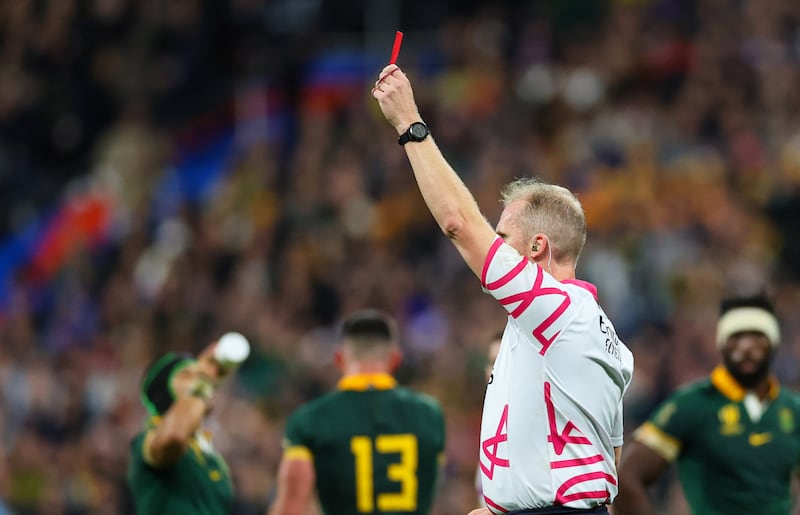On the Thursday before the Six Nations clash with Scotland, the announcement of Ireland’s team included the name of Calvin Nash. He had failed a head injury assessment just five days earlier.
While Nash passed all the protocols to enable his selection, many eminent rugby people, medics included, are adamant that the seven-day return to play period that is permitted is far too short.
Meanwhile, the England player Immanuel Feyi-Waboso reported his own brain injury symptoms, effectively sidelining himself for their final match.
The elephant in the room is Chronic Traumatic Encephalopathy (CTE) which translates as severe, degenerative brain damage. It is only possible to diagnose by postmortem autopsy, and is caused by repetitive blows to the head that are not confined to concussion. Dr Ann McKee is the expert head of research at Boston University’s CTE Centre, and the findings from her department make for grim reading.
Autopsies conducted in the centre last year examined the brains of 152 donors who died between the young ages of 13 and 30. Most were American football players, but other sports, such as ice hockey, boxing and rugby, were also on the list, which covered professional and amateur players.
The results showed that 63 – or 41 per cent – were diagnosed with early onset CTE.
“This shows that the pathology starts early. The fact that over 40 per cent of young contact and collision sports athletes in the brain bank have CTE is remarkable – considering that studies of community brain banks show that fewer than 1 per cent of the general population has CTE,” explained Dr McKee.
Soon enough, we will hear more from the courts in relation to the action of former players suffering from dementia and probable CTE.

The human toll from brain injuries is devastating. There was the tragic suicide last year of 33-year-old former Maori player, Billy Guyton. His symptoms, outlined recently by his father, were harrowing. Guyton’s donated brain showed clear evidence of CTE.
And don’t forget Siobhan Cattigan, the young Scotland international player who also died tragically at the age of 26. Or that four young French players died from rugby injuries, also in recent times.
For many there is no better sight than young kids playing rugby. The fun, enjoyment, and friendships formed are an invaluable part of growing up into adulthood. The benefits are lifelong, but this great game faces huge challenges. Despite all the good the sport provides, there is a major dilemma for parents in selecting rugby for their children.
Professionalism has seen the arrival and inexorable growth of brutal collisions, with the head frequently in the equation. Inevitably, what happens at the top end of the sport is copied at club and school level. The school cups this year were again full of excellent rugby, and also full of enormous physicality, a facsimile of the pro-game.
So, what are World Rugby doing about it?
Well, their recent Shape of the Game forums have reported and the press release is an interesting read. While “safety and player welfare” are mentioned, and the “croc roll” is heading for extinction, the proposals focus primarily on entertainment value.
We have also heard in recent times about finding the right balance between safety and spectacle, rather than considering safety as the absolute priority, not something you need to balance with anything.
In May, the World Rugby Council will consider recommendations from their recently-formed specialist groups. They will debate the divisive issue of the 20-minute red card replacement, perhaps accompanied by stronger sanctions for offenders.
I hold the strong belief that this debate must be confined to actions where the tackler has little time to adjust, for example New Zealand’s Sam Cane in the World Cup final. Brutal foul play cannot be accompanied with the luxury of a replacement. It would be sheer folly and fly in the face of Dr McKee’s findings.

A key element will be their deliberations around the breakdown, a review of safety and spectacle issues – “for example, the impact of contesting the ball on the floor, jackal as opposed to an upright driving game”.
This is a very important opportunity to keep players on their feet, and outlaw the action of flying into the breakdown, which has become a progressively violent area.
On the other hand, the persistent tactic of “pick and drives”, with players leading with their heads, doesn’t seem to be mentioned.
The whole question of replacements is also on the table, including when and how they should be used. This will involve analysing “the number and the timing of replacements, player fatigue, and what options might create more space on the field, while improving injury rates”.
There is a fundamental need for World Rugby to rid the game of danger, and to heed Dr McKee’s research. So, it’s imperative that the Council measures relevant law proposals against the primary necessity of eliminating collisions involving the head. Rather than making the mistake of overconcentrating on what the chair, Bill Beaumont, enthusiastically describes as “embracing change by dialling up the entertainment value.”
Both are of high relevance, and both can surely be delivered, they are not mutually exclusive.
Finally, there are numerous suggestions that specific law changes for club and schools are required. Fergus Slattery, the great Ireland and Lions player of yesteryear, was a strong advocate for it, before his own battle with severe dementia.
Such a law move could well be the only pathway which ensures the long-term survival of rugby at these amateur levels.






